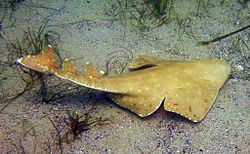Angelshark
An Angelshark is a species of cartilaginous fish in the genus Squatina. They have flattened bodies and wide pectoral fins, which make them look similar to rays. Twenty-three species are known.
| Angelshark Temporal range: Oxfordian to Present
| |
|---|---|

| |
| Australian angelshark (Squatina australis) | |

| |
| Sand devil (Squatina dumeril) | |
| Scientific classification | |
| Unrecognized taxon (fix): | Squatina |
| Type species | |
| Squalus squatina | |
The genus is the only one in its family, Squatinidae, and order Squatiniformes. They are worldwide in temperate and tropical seas. Most species are in shallow temperate or tropical seas, but one species is found in deeper water, down to 1,300 metres. [1] Angelsharks are specialised for a kind of predation which is unusual for sharks. They are ambush predators. They have extensible jaws with long, needle-like teeth. They quickly snap upwards to capture prey. They bury themselves in sand or mud lying in wait for their prey, which includes fish, crustaceans, and many different types of mollusks.[1]
Discription and biology
The front part of the angel sharks' bodies are wide and flattened, but the back part is more muscular. The eyes and spiracles are on the top, and the five gill slits are on its back. Both the pectoral fins and the pelvic fins are large and are held horizontally. There are two dorsal fins, no anal fin. Unusually for sharks, the lower lobe of the caudal fin is longer than the upper lobe. Most types of angel sharks grow to a length of about 1.5 metres: the Japanese angelshark reaches two metres.[2] They are ovoviviparous, and can have up to 13 pups at a time.
Behavior
Although angelsharks are bottom dwellers and appear harmless, they can give painful bites if provoked, due to their powerful jaws and sharp teeth. Angelsharks may bite if a diver approaches the head or grabs the tail.[3]
Angelshark Media
Angelsharks, off the coast of Fuerteventura
References
- ↑ 1.0 1.1 Stevens J. & Last P.R. (1998). Paxton J.R. & Eschmeyer W.N. (ed.). Encyclopedia of Fishes. San Diego: Academic Press. pp. 64–65. ISBN 0-12-547665-5.
- ↑ "FAMILY Details for Squatinidae-Angel sharks". fishbase.org. Retrieved 8 July 2013.
- ↑ Best, Cathleen. "Florida Museum of Natural History." PACIFIC ANGEL SHARK. (Date accessed 06/23/2010) <http://www.flmnh.ufl.edu/fish/gallery/descript/pacificangelshark/pacificangelshark.html Archived 2014-11-12 at the Wayback Machine>.
